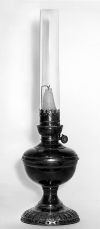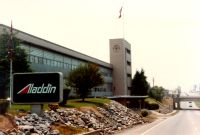Several events were to affect The Mantle Lamp Company during the early 1940s. As the nations war effort intensified, the manufacture of electric lamps was temporarily discontinued in 1943. Aladdin was granted permission to use copper by the War Production Board during World War II and manufacture kerosene burners for glass kerosene lamps. The usage of Aladdin kerosene lamps reduced the need for copper wire to electrify homes and thereby further aided the war effort. The Aladdin kerosene burner was used in the famous Servel and Electrolux refrigeration units which preserved serum and plasma on the battlefields. The company also developed several items essential in the war: a midget foxhole stove and a pressure lantern both of which burned leaded or white gasoline; a barometric bomb detonation fuse; permeability tuning for radios; and precision parts for military radio equipment. Meanwhile, the thermos bottle became one of Aladdins principal products in the domestic market.
The Aladdin Mantle Lamp Company is proud to continue the 90-year tradition of manufacturing Aladdin lampsthe finest non-electric lamp in the world. The company is building a new home for the Aladdin lamp in Clarksville, Tennessee.
The initial sales of the Aladdin were beyond all expectations. It was so much more efficient than other mantle lampsto say nothing of the conventional flat and round wick lamps of the daythat it quickly made other kerosene lamps obsolete. Soon the Aladdin could be found throughout the United States and Canada, and ultimately it made its way around the world.
Johnson established a small research department early in the history of the company. His recognition of the need for improving quality through research was ahead of the times. Today a research and development department is considered vital by virtually all manufacturers.
In August 1998 Bill Courter and Tom Teeter approached Aladdin to buy the Lamp Division. With 11 additional investors from the Aladdin Knights, plus a share of ownership by Aladdin, the new company was formed and the transaction closed in April 1999.
Undoubtedly the preeminence of the Aladdin through a half-century of competition was due to the continual development of improved models to provide dependable operation, increased illumination, greater safety, and, in general, a foolproof lamp. These achievements were largely the results of research accomplishments by Charles H. Smith, Cortland W. Davis, W. B. Engh, Fred Spangler and Eugene Schwarz.

Properly adjusted, the Practicus produced white light of about 60 candlepower. The burner was designed to fit common American-made lamp fonts. However, the Practicus, with its single wire mantle support, often went out of adjustment, required constant attention and the slim chimneys cracked. Because of these shortcomings, Johnson searched for a better mantle lamp.
Industries, Inc.) taking the latter name as being more representative of its diverse products. In the same year, the vacuum-ware operations were moved from Alexandria to Nashville, Tennessee. Aladdins Hopalong Cassidy lunch box changed the way children carried their lunch to school for the next 20 years.
The Aladdin kerosene lamp gained a resurgence of renewed interest when the company began importing attractive brass lamps from England in 1967 and reissued its 601 shade in 1971 and the Short Lincoln Drape in 1974. Many colors of the Short Lincoln Drapes have since been made and the variety of lamps and shades has gradually increaseda big change from the previous decadeto capture the nostalgia of years past. Special limited edition lamps were made to commemorate Aladdins 70th anniversary in 1978 and its 75th in 1983. Several decorator lamps were added during this period as well as special designs for L.L. Bean and Eddie Bauer. Aladdin has commissioned the Fenton Art Glass Co. to make lamps since 1991. The Grand Vertique, the first new lamp design in many years, was created in 1994.
His son, V. S. Johnson, Jr., took over the reins and provided leadership for further growth and expansion after discharge from the army in 1945. He initiated plans to build a new plant in Nashville, Tennessee, and to expand the production of Aladdin thermos bottles. In 1949 he moved the main offices from Chicago to modern facilities in Nashville, where the company remainstoday.
The KoneKap mantle was the first mantle to be made by the company itself. In 1911 the company claimed to be the only lamp house in the world that manufactures its own mantles. The company furnished mantles for competitive lamps as well as for the Aladdin. The Lox-On® mantle, commonly used today, was patented in 1931.
Fifteen models of Aladdin lamps have been made in the United States since 1909. Domestic manufacture was suspended in 1963 and Models 21C and 23 were imported from England and Model C from Brazil. Not all models made in England were imported for sale in the U.S. More recently, Model 23 lamps have been made in Hong Kong. Aladdins (lamp bowls and fonts; not burners) were also made in Argentina and Australia.
Aladdin sold its health care and food service systems, formerly known as Aladdin Synergetics, to the Welbilt Corporation in 1998. The new operation under Welbilt is called Aladdin Temp-Rite.
Electric Aladdin lamps were sold beginning in 1930. Unique deco designs made Aladdin electric lamps popular in major cities during the 1930s and 1940s.
V. S. Johnson, Jr. retired as chairman of Aladdin Industries in 1985. His son, Victor S. Johnson III, District Attorney General, Nashville, currently serves as vice-chairman on the Board of Directors.
In 1915, Model 6 earned a gold medal and a blue ribbon in competition at the Panama-Pacific International Exposition at San Francisco. The Mantle Lamp Company boldly proclaimed the Aladdin as the best kerosene lamp in the world. An offer of $1000 was made for any oil-burning lamp that could equal the Aladdin in 26 important features. This offer was never collected.
Improvements and New Models of Lamps
In 1905 Johnson first saw the superior light produced by a German kerosene mantle burner, the Practicus. This lamp was imported into the USA by the Connecticut Trading Company. Remembering the poor light by which he studied as a youth, Johnson recognized the potential for sales of mantle lamps in rural areas. At last, people without electricity could have good light.
The Aladdin Knights, an eclectic collector organization formed in 1973 to collect and preserve Aladdin memorabilia. The Aladdin Knights created much interest in Aladdin lamps and today sponsor an international lamp show and sale. Their website is
In 1926, The Mantle Lamp Company acquired the Lippincott Glass Company land and buildings on the outskirts of Alexandria, Indiana. A new, large, modern factory was built on the thirteen-acre site which was later incorporated as a village with the name Aladdin. With just 22 residents, Aladdin was the smallest town in Indiana in 1928.
The first major breakthrough were inventions, that led to Model No. 3, patented in 1911 by Charles H. Smith (assignor to The Mantle Lamp Company of America, Chicago, Illinois). Model 3 featured a combined mantle cap and burner cone (KoneKap Mantle), improved construction and a new air distributor or gasifier (flame spreader).
The development of improved Nu-Type side-draft burners, introduced in 1932-34, permitted the use of glass for lower cost and design of colorful fonts. In the ten-year period following introduction of Nu-Type burners, Aladdin produced many of its most beautiful and collectible glass kerosene table lamps.
Victor Samuel Johnson made the Aladdin mantle lamp a household word throughout America. Born February 6, 1882, in a sod farmhouse five miles south of Minden, Nebraska, he grew up on that farm, studying his school lessons by the flame of a common kerosene lamp. He learned his lessons well, and by 1904 was a bookkeeper and salesman for the Iowa Soap Company in Burlington, Iowa.

V. S. Johnson died unexpectedly in Washington, D.C. on August 29, 1943.
Aladdin Industries Inc. reorganized in 1999, changed to Aladdin Industries LLC and Ari Chaney replaced Fred Meyer as President and CEO.
The new factory was built at a time when there was still a large market for kerosene lamps. As the 1930s approached, an estimated six million farm homes depended on kerosene or gas for lighting. Aladdin now manufactured its own glass chimneys, shades and lamp bases. The company soon followed by making their own mantles, wicks and fabricating metal lamp bases in Alexandria.
Victor Johnson gave up his steady job in 1907 and formed the Western Lighting Company in Minneapolis, Minnesota. The company obtained rights to sell the Practicus, foreign-made mantles, and other foreign alcohol-burning lamps. Soon after the Practicus was successfully introduced at a hardware dealers convention in Kansas City, Johnson moved the business to Chicago, Illinois. On February 27th, 1908 he incorporated The Mantle Lamp Company of America. At that time Johnson estimated there were about 65 companies distributing kerosene mantle lamps in the USA and only 9 or 10 manufacturers world-wide.
The Mantle Lamp Company established subsidiaries in Greenford, England (1919); Sydney, Australia (1923); and Buenos Aires, Argentine Republic (1925) to distribute Aladdins around the world.
Today the principal items manufactured by Aladdin Industries LLC are glass and stainless steel vacuum bottles; Stanley bottles and mugs; workmens lunch boxes; several insulated beverageware items; flashlight products; and related outdoor hunting accessories.

Aladdin Industries, Inc. was formed as a subsidiary of The Mantle Lamp Company in 1919 in Chicago to make and sell Thermalware® and vacuum bottles. In 1949, The Mantle Lamp Company of America merged with its subsidiary (Aladdin
The Alexandria plant was closed June 30, 1952 after the death of inventor and designer Eugene Schwarz. At that time all molds for the glass kerosene and electric lamps were sold as scrap and destroyed. The lamp manufacturing operations, by now greatly reduced, were moved from Alexandria to Nashville. Domestic sales of kerosene lamps declined significantly during the ensuing years. Inexpensive glass and aluminum lamps made in Brazil were sold mostly for utility and emergency use. Export sales and the demand for replacement parts were sufficient to keep lamps in the company inventory. The production ofAladdin electric lamps ceased in 1956.
The Aladdin lamp became a reality when Johnson acquired improved center-draft burners patented by Charles E. Wirth (assignor to Plume and Atwood Manufacturing Company, Waterbury, Connecticut). Early in 1909 Johnson introduced the Aladdin lamp. He derived the name from the famous story, Aladdin; or The Wonderful Lamp where a magician offered new